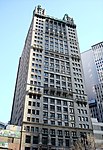Park Theatre (Manhattan)

The Park Theatre, originally known as the New Theatre, was a playhouse in New York City, located at 21–25 Park Row in the present Civic Center neighborhood of Manhattan, about 200 feet (61 m) east of Ann Street and backing Theatre Alley. The location, at the north end of the city, overlooked the park that would soon house City Hall. French architect Marc Isambard Brunel collaborated with fellow émigré Joseph-François Mangin and his brother Charles on the design of the building in the 1790s. Construction costs mounted to precipitous levels, and changes were made in the design; the resulting theatre had a rather plain exterior. The doors opened in January 1798. In its early years, the Park enjoyed little to no competition in New York City. Nevertheless, it rarely made a profit for its owners or managers, prompting them to sell it in 1805. Under the management of Stephen Price and Edmund Simpson in the 1810s and 1820s, the Park enjoyed its most successful period. Price and Simpson initiated a star system by importing English talent and providing the theatre a veneer of upper-class respectability. Rivals such as the Chatham Garden and Bowery theatres appeared in the 1820s, and the Park had to adapt to survive. Blackface acts and melodrama squeezed Italian opera and English drama out of their preferential positions. Nevertheless, the theatre maintained its upscale image until it burned down in 1848.
Excerpt from the Wikipedia article Park Theatre (Manhattan) (License: CC BY-SA 3.0, Authors, Images).Park Theatre (Manhattan)
Park Row, New York Manhattan
Geographical coordinates (GPS) Address Nearby Places Show on map
Geographical coordinates (GPS)
| Latitude | Longitude |
|---|---|
| N 40.711512 ° | E -74.0076 ° |
Address
25 Park Row
Park Row 25
10038 New York, Manhattan
New York, United States
Open on Google Maps










